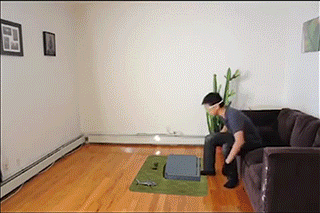Designing physically present digital media
Spatial Computing is a concept Augmented Reality (AR) system that makes digital media feel physically present through interaction design. It is presented as a 3 part video series:
Part 1
A New Paradigm
A brief history of HCI and a how to get computers to think in the same three-dimensional way humans do
Part 2
Shopping
A gesture vocabulary for object manipulation through the use case of shopping for furniture in your living room
Part 3
The Home Theater System
A reuse of the gesture vocabulary from Part 2 to navigate 3d environments, demonstrated through the use case of 3d home media (sports, 3d narrative content, etc...)
About the project
The human body's capacity to move freely is empowering. When people cannot move, they are locked inside their brains, unable to express feelings or perspectives or to share with others. With physical movement, people can communicate through language and art and dance and song.
But the human brain's ability to model movement doesn't stop at the ends of our fingertips. Our neuroplastic brains incorporate physical objects so that they become part of our bodies. So our capacity to communicate relies not only on our ability to control our bodies, but our ability to control our environments.
The virtual objects of Spatial Computing are designed to extend the user's agency so as to empower. It is self-expression through object and environment manipulation. This manipulation should be as joyful as tumbling around on a playground.
The project is heavily inspired by my background in illusion-based dance and theater, traditions that are obsessed with mapping human intention to compositional outcome. This work is different from other depictions of futuristic interaction designs in that the mapping is sufficiently explained, giving the viewer a physical sense of what the future will feel like to their kinesthetic bodies.

